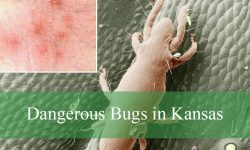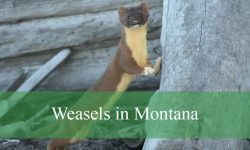Florida’s wild landscapes are home to a fascinating variety of reptiles, and among the most well-known are rattlesnakes. These venomous pit vipers are recognized by the distinctive rattle at the tip of their tails, a feature that sets them apart from other snakes. While they inspire caution, rattlesnakes are also an important part of Florida’s ecosystems, helping control populations of rodents and other small animals.
In the Sunshine State, only three species of rattlesnakes are native. Each species has unique characteristics that make it identifiable in the field. Learning to recognize these snakes not only improves safety but also builds appreciation for the role they play in nature. Rattlesnakes are generally shy and prefer to avoid humans, but they will defend themselves if cornered or provoked.
This guide explores the three rattlesnakes of Florida in detail. You’ll learn about the Eastern Diamondback Rattlesnake, the Timber Rattlesnake, and the Dusky Pygmy Rattlesnake, with notes on their appearance, habitat, and behavior. By the end, you’ll have a clearer picture of how to identify them and what to do if you encounter one in the wild.
Eastern Diamondback Rattlesnake in Florida
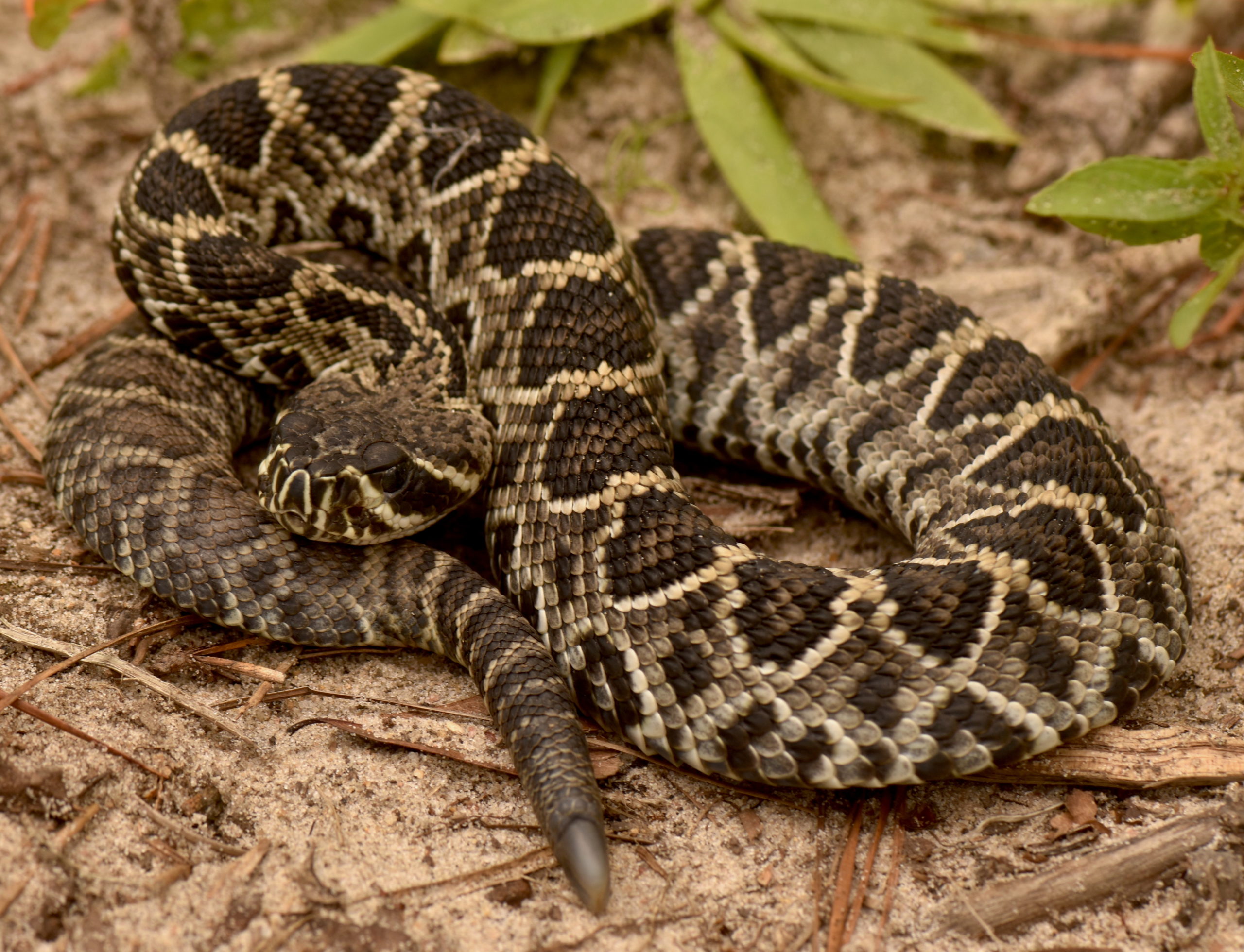
The Eastern Diamondback Rattlesnake (Crotalus adamanteus) is the largest rattlesnake in the world and one of Florida’s most iconic reptiles. It thrives in pine flatwoods, sandhills, and coastal scrub habitats, often sheltering in abandoned gopher tortoise burrows. With its bold diamond-shaped patterns outlined in yellow or cream, it is both striking and intimidating. Adults usually grow between three and six feet long, though some have been recorded at more than seven feet.
Its appearance is unmistakable. A heavy body, broad triangular head, and dark diamonds on a lighter background make this snake easy to recognize. At the tip of its tail, the rattle produces a sharp buzzing noise when shaken, warning potential threats. The coloration also serves as excellent camouflage against leaf litter and sandy soil, allowing the snake to remain hidden until disturbed.
Despite its fearsome reputation, the Eastern Diamondback prefers solitude and will avoid humans when possible. It is a patient ambush predator, lying in wait for rabbits, rodents, and birds. When prey approaches, it strikes with lightning speed and uses potent venom to immobilize the animal. While its venom can be life-threatening to humans, bites are relatively rare because the snake typically rattles a warning before striking.
In Florida, the Eastern Diamondback is still fairly widespread, though its numbers have declined due to habitat loss and urban expansion. Conservationists emphasize the importance of protecting longleaf pine ecosystems, which support not only rattlesnakes but also countless other species that depend on these unique habitats.
Timber Rattlesnake in Florida
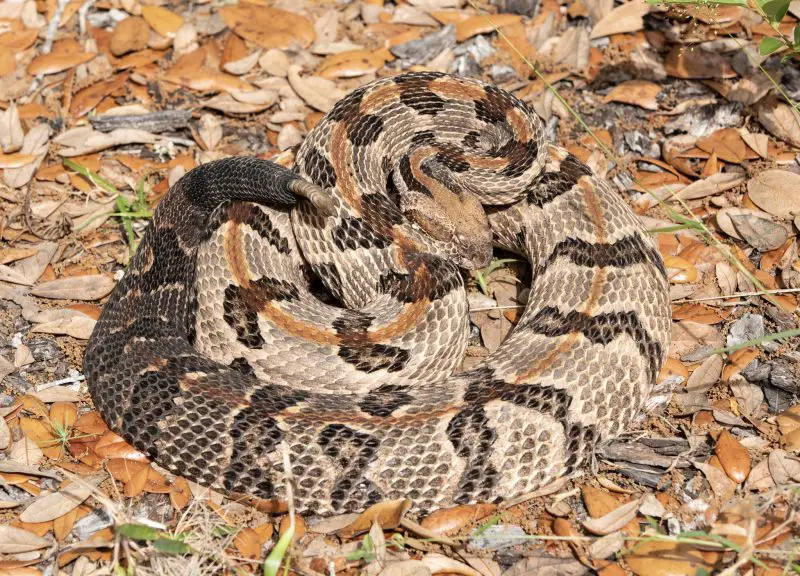
The Timber Rattlesnake (Crotalus horridus), sometimes called the canebrake rattlesnake in the Southeast, has a far more limited distribution in Florida than the Eastern Diamondback. It is mostly found in the northern part of the state, especially in hardwood forests, pine woods, and swampy lowlands. Its preference for dense forests makes it harder to encounter, and it is considered rare within Florida’s borders.
This species is striking in appearance. Its body ranges from gray to tan, with bold dark crossbands running across its back. A rust-colored stripe may also run along the center of its spine, creating a distinctive feature for identification. Timber Rattlesnakes are slimmer than Eastern Diamondbacks but still impressive, usually measuring between three and five feet in length. Like all rattlesnakes, they have the iconic rattle that produces a buzzing sound when threatened.
Behaviorally, Timber Rattlesnakes are often described as more tolerant or docile compared to other venomous snakes. They will usually remain motionless when approached, relying on their camouflage, but will defend themselves if provoked. They feed primarily on small mammals and birds, serving as effective rodent control within their habitats.
In northern states, Timber Rattlesnakes hibernate during the winter. In Florida’s warmer climate, they remain active for longer periods but may still become less active in cooler months. Because their population is small and limited in range, they are considered a species of conservation concern in the state. Protecting forested habitats is crucial to ensuring their survival in Florida’s ecosystems.
Dusky Pygmy Rattlesnake in Florida
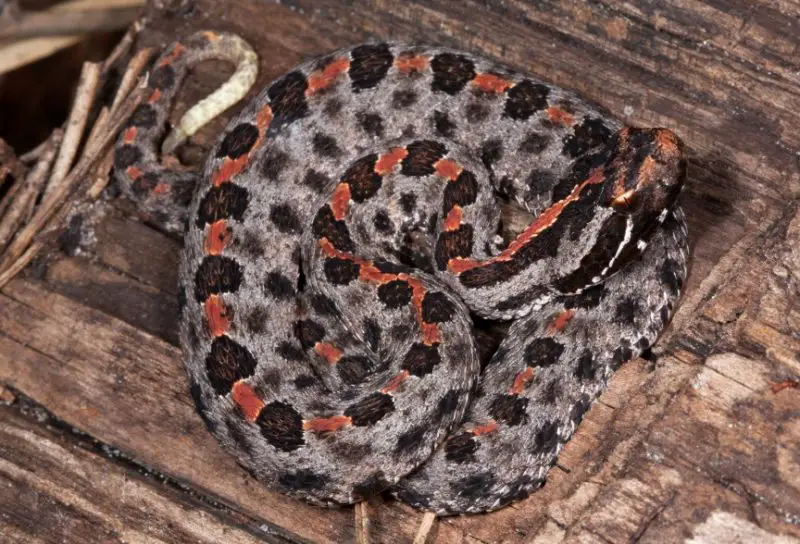
The Dusky Pygmy Rattlesnake (Sistrurus miliarius barbouri) is Florida’s smallest rattlesnake but also the most commonly encountered. Adults typically measure just 15 to 24 inches long, yet they are stout-bodied and highly noticeable when disturbed. They are found in a wide range of environments, including pinewoods, marshes, swamps, and even near residential areas. Unlike the larger rattlesnakes, the Dusky Pygmy is often spotted near water, where amphibians and lizards provide abundant food.
This snake has a gray background color with rows of dark blotches running down its back. A reddish-brown dorsal stripe may also appear, adding to its distinct look. While it does possess a rattle, it is very small and produces only a faint buzzing sound. Many people mistake it for an insect noise, which means they often get very close to the snake before realizing it is there.
The Dusky Pygmy is known for its bold attitude despite its small size. It does not hesitate to strike when threatened and is more defensive than its larger relatives. Its venom is less potent than that of the Eastern Diamondback, but a bite can still cause painful swelling, tissue damage, and medical complications if not treated promptly.
Because of its adaptability, the Dusky Pygmy Rattlesnake is found across nearly the entire state of Florida. Encounters are common along hiking trails, in fishing areas, and even in suburban yards. While it is not a major threat if left alone, awareness is essential to prevent accidental bites. Giving this small but feisty rattlesnake space is always the best choice.
Comparison of the Three Rattlesnakes in Florida
A vertical comparison makes it easier to see the unique features of each rattlesnake species found in Florida. Below is a breakdown of their size, appearance, habitat, venom, and distribution.
Attribute |
Eastern Diamondback Rattlesnake (Crotalus adamanteus) |
Timber Rattlesnake (Crotalus horridus) |
Dusky Pygmy Rattlesnake (Sistrurus miliarius barbouri) |
|---|---|---|---|
Average Size |
3–6 feet, occasionally over 7 feet |
3–5 feet |
15–24 inches |
Appearance |
Heavy body, bold dark diamonds outlined in yellow or cream |
Gray or tan body with dark crossbands and a rust-colored dorsal stripe |
Small, gray with dark blotches and a faint reddish stripe |
Habitat in Florida |
Pine flatwoods, sandhills, coastal scrub, gopher tortoise burrows |
Hardwood forests, pine woods, swamps |
Marshes, pinewoods, swamps, suburban edges |
Venom Potency |
Highly potent, potentially life-threatening |
Potent and dangerous, but less frequently encountered |
Less potent than larger species, but still medically significant |
Distribution |
Statewide, more common in rural areas |
Restricted to northern Florida counties |
Widespread across Florida, commonly encountered |
Rattlesnake Safety and Identification in Florida
Identifying rattlesnakes correctly is important for anyone spending time outdoors in Florida. The Eastern Diamondback stands out with its massive size and bold diamonds, the Timber Rattlesnake is recognized by its crossbands and rust-colored stripe, and the Dusky Pygmy is much smaller with dark blotches and a faint rattle. These features help distinguish them from non-venomous snakes.
Rattlesnakes rarely attack humans without warning. Most bites occur when people try to handle, kill, or accidentally step on them. Wearing boots in tall grass, watching where you place your hands and feet, and keeping a safe distance if you hear a rattle are all simple steps that reduce risk. If bitten, medical attention should be sought immediately, as venom can cause serious complications.
In Florida, rattlesnakes are not just threats to avoid—they are essential predators. By keeping rodent populations in check, they help maintain balance in natural ecosystems. Understanding their role and respecting their presence allows humans and rattlesnakes to coexist safely.
Conservation and Human Interaction
Rattlesnakes in Florida face multiple challenges, including habitat destruction, road mortality, and persecution by humans. Many people kill them out of fear, even though these snakes prefer to avoid encounters. The Eastern Diamondback has seen declines due to the loss of longleaf pine forests, while the Timber Rattlesnake remains rare and localized in northern counties. The Dusky Pygmy is still common, but its proximity to human areas leads to frequent conflicts.
Education and conservation efforts are key to protecting rattlesnakes. Preserving natural habitats, reducing unnecessary killing, and teaching safe coexistence strategies all contribute to their survival. Simple awareness—such as knowing that rattlesnakes warn before striking—can reduce fear and prevent harm to both people and snakes.
By protecting rattlesnakes, we also protect the health of Florida’s ecosystems. These reptiles are indicators of environmental health, and their decline often signals broader ecological problems. Supporting conservation benefits not just rattlesnakes but countless other species that share the same habitats.
Conclusion
Florida is home to three rattlesnake species: the massive and iconic Eastern Diamondback, the rare but striking Timber Rattlesnake, and the small yet bold Dusky Pygmy Rattlesnake. Each one contributes to the natural balance of the state’s ecosystems by controlling populations of small mammals, birds, and amphibians.
Though feared, rattlesnakes are generally reluctant to strike unless provoked. By learning to identify them and understanding their behavior, people can reduce risk and gain a deeper respect for these fascinating reptiles. Their presence in Florida is a reminder of the state’s rich biodiversity and the importance of protecting wild spaces.
With proper knowledge and awareness, it is possible to coexist with rattlesnakes safely. Appreciating their role in nature turns fear into respect, ensuring that these remarkable snakes continue to thrive in Florida’s forests, wetlands, and fields for generations to come.
FAQs About Rattlesnakes in Florida
Are rattlesnakes common in Florida?
Yes, rattlesnakes are fairly common in Florida, especially the Eastern Diamondback and the Dusky Pygmy Rattlesnake. The Timber Rattlesnake is present but much rarer, only found in northern counties. While sightings are not unusual, most rattlesnakes prefer to stay hidden and avoid humans.
What is the most dangerous rattlesnake in Florida?
The Eastern Diamondback Rattlesnake is considered the most dangerous in Florida due to its large size and highly potent venom. Its strike can deliver a significant amount of venom, making it potentially life-threatening. Despite this, it usually rattles a warning before striking and avoids confrontation when possible.
Where am I most likely to encounter a rattlesnake in Florida?
Encounters are most likely in natural areas such as pine flatwoods, marshes, forests, and swamps. The Dusky Pygmy Rattlesnake is especially common near water sources and even around suburban edges. Hikers, hunters, and outdoor enthusiasts should stay alert in these habitats.
Do rattlesnakes hibernate in Florida?
In Florida’s warm climate, rattlesnakes do not undergo true hibernation like they do in northern states. However, they may become less active during colder months, particularly the Timber Rattlesnake in northern regions of the state. They remain active throughout much of the year.
What should I do if I encounter a rattlesnake?
If you encounter a rattlesnake, the best response is to remain calm and give the snake space. Do not attempt to handle, capture, or kill it. Most rattlesnakes will retreat if left alone. If you hear the rattle, back away slowly and avoid sudden movements.
How dangerous is a Dusky Pygmy Rattlesnake bite?
Although the Dusky Pygmy Rattlesnake is much smaller than the Eastern Diamondback, its bite is still medically significant. The venom can cause swelling, tissue damage, and pain, but fatalities are extremely rare. Immediate medical attention is always recommended if bitten.
Are rattlesnakes protected in Florida?
Rattlesnakes are not fully protected in Florida, but they are important native species. Some populations, such as the Timber Rattlesnake, are considered species of concern due to their rarity and habitat loss. Conservation efforts focus on habitat preservation and reducing unnecessary killing.


